Aviary, the online creative platform is a visionary tool. When it launched a few years back, the irony of a Flash based Photoshop competitor was, well, ironic.

With the launch of Aviary in Google’s App Marketplace, we can say that the company is close to making lightening strike twice, this time around creating a home for the creative professional and their most important assets.
We want this to work – so we ran it through the paces. Here we got a front-line view on where cloud app meets cloud. We looked forward to counting the pixels that get wasted in the process.
Aviary and Google will disrupt Microsoft (the default filesystem for the world), and along side it Apple and Abobe, with this simple joining of services that allows users to create, share, publish and present with a simple Web based client and “always available” files.
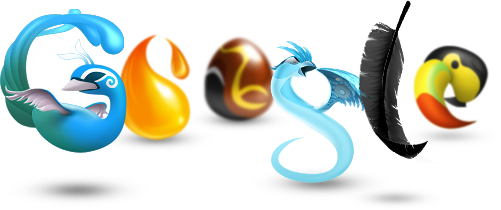
It feels like the tide has changed and soon it will be hard to imagine an app not defaulting to file storage in the cloud. In a world of cloud-hosted apps, writing to a PC filesystem just seems wrong and goes against the grain of a mobile workforce. The creative professional’s cloud is going to be in vivid color and available from the local coffee shop.
As a clear sign of preparation for these applications, Google Docs recently started accepting files of any type.
If you’re a user, you’ll likely see this headline at the top of your account, like we do.

Google Supports a Virtual File System for Business Documents
For images, this is useful for people who use Google’s presentation software. Today, all of your other files are online. Now you can have your images close at hand, so it’s easy to use all files whene you need them, as shown here in this piece by Aviary and Google.
In this Google Docs upload feature demonstration, we see that Google interprets certain filetypes and offers a way to convert into a native Google file format upon uploading. When this happens with an Office-based document, for example an .docx file, Google will process it as needed to be usable in the Google Docs document editor.
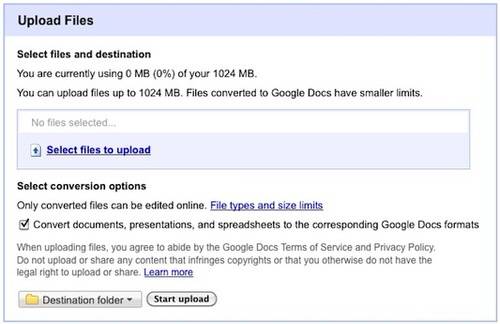
Aviary is part of Google Apps Marketplace and part of the Google Docs application.
Coming from the Aviary side of the world, we see this as a natural extension to the work the company has done in joining accounts with Flickr, Facebook, and others. Images need editing. And to be shared many times over. Aviary makes it easy to get started with Google using a third-party login capability to join accounts with Google.

When this sharing hits productivity apps like presentations., that’s where we start to see an interesting landscape emerging. Google is playing the role as a peer (e.g. share images with multiple editors) and also is moving towards the “cloud of choice” for consumer document management.
Below is a Google Apps-powered Google Docs listing after Aviary has been installed. Aviary is now available as an editor, a library has been created for Aviary documents, and when saving a document in a properly configured Aviary-Google account, a list of Aviary docs will show up in the main listing.
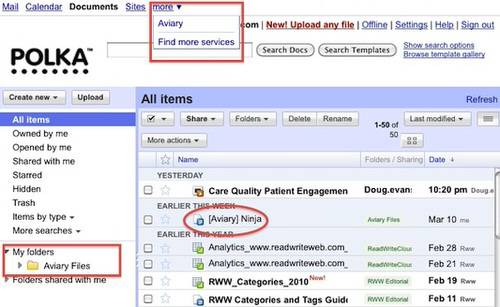
A page opens with a view of the image and the option open the image in Aviary.
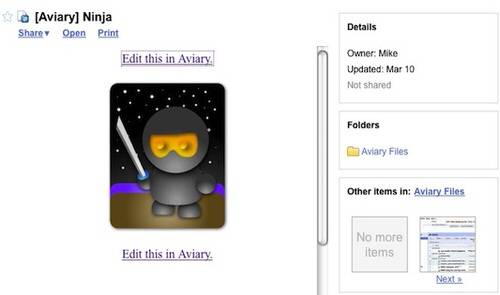
Our ninja file is edited and saved…
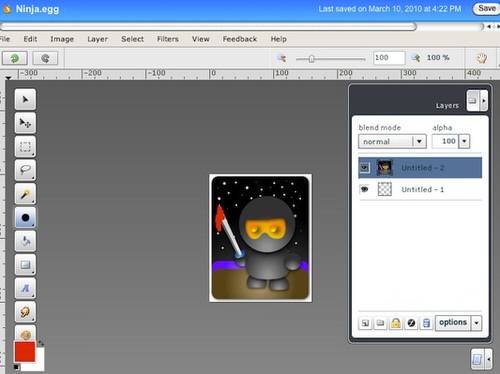
Mime Type 2.0
In practice, all of this marketplace integration is harder than it might first look.
This is a a few of the features and or landscape issues that make this experience “not quite” the same as saving a file from Photoshop to Windows.
- Multiple entry points can be confusing to newcomers. We found that by going to Aviary.com and launching versus launching from Google docs that there were subtle features and connections that worked differently (in our account, it offered different views of the total image library). Also, which repository was setup as the default. In a way, both models need to be supported, but even subtle differences can make the overall solution more error-prone.
- What are the the default for saving new file. We notice this especially when moving files from Google and expecting to see them in Aviary. Like setting up a specific application to open for certain files, in the case that there are dual masters (or apps), this becomes much more difficult to edit on. We would like (at least) Google to recognize more about the file post-Aviary and launch it when I bring in new images (or at least offer to). This begs the interesting question of whether a person’s files should have a default home.
- On the reverse side, “Save As” to your Google Docs from Aviary may need fine tuning. This is a software and workflow challenge that didn’t exist when there was an implied “master” of all the files. We see this challenge existing also with the desktop experiences and how the apps react to changes from these repositories. In a way, if Google Apps was master for all the docs, it would move the experience forward. But, Windows, Photoshop, and even Aviary, may feel different.
- Does the likelihood of failure increase due to interdependencies as well as other factors that make the services less predictable? After a brief error or two in getting Aviary to Save to Google rather than Save to Aviary, a few things of note. 1: Helping the user know what is happening is going to be important, especially if two (or more) ways are supported. 2: This needs to be as easy as finding “My Documents” on the PC, or adoption will suffer.
This is Aviary in “Google mode” and trying to save the document to Google Docs account, but not completing the job. ( We’re not saying it doesn’t work, just that it doesn’t work sometimes.)

Creative professionals may not use Aviary as their default tool… yet. And Google Docs may not be as fast or be as reliable as a PC. But for those of us who do light image edits and are Google Doc users, this is a major leap forward.
We see this as an unlocking of the desktop (both machine and software) and love the promise of creating anywhere, storing anywhere, getting paid.
As this starts to work, it’s clear that Google, Aviary, and cloud applications will continue to encroach in the workflow of things to come.
Where’s your limit to what you do with Aviary and Google Apps in a Google Cloud?





















